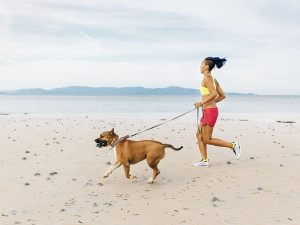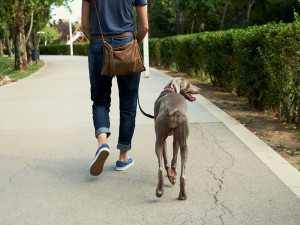How to Run Safely and Happily With Your Dog
Keen to hit the road and get fit with your pup? Read this first

Share Article
I am at my happiest running along trails with my dogs.
Combining our exercise routines saves me time and sharing our love of running has helped deepen the bond with my dogs. As an unexpected bonus, running with dogs has boosted my social life. In fact, I love running with my dogs so much that 10 years ago, I co-founded Cani-Sports Edinburghopens in new tab, a running club that’s helped hundreds of people get fit and have fun running with their dog.
So, if you’d like to find out if your dog is a suitable companion for your running adventures, learn how to get started, find out whether you need any special gear and figure out how to stay safe, happy and healthy out there running with your pup, read on.
Should you run with your dog?
Before you start running with your dog, the first thing to do is consider is whether they would make a good running buddy. For starters: are they the right age?
RSPCA dog welfare expert and veterinary nurse Lauren Bennett says, “We’d advise owners with young dogs to avoid high-impact exercise until they’ve finished growing and developing, which can be between one and two years old depending on their size.” She says there make also be risks for dogs over seven as they can be prone to joint problems. That’s not to say dogs older than seven can’t run, it’s just important to be cautious and aware of their needs. Schedule a chat with your vet to discuss if you have any reservations.
“One of the most important considerations is whether your dog enjoys running,” Lauren continues. “All dogs are individuals, and they don’t all like to do the same things. We’d encourage owners who want to run with their dogs to also offer their pets other forms of exercise as well as providing them with plenty of mental enrichment.”
RSPCA chief vet Caroline Allen says, “Dogs suffering from a health condition or who are overweight may not be able to run with you so you should speak to your vet first. We also wouldn’t recommend running with certain breeds who are susceptible to health problems due to their extreme breeding – such as flat-faced dogs (think: Pugs or French Bulldogs) who struggle to breathe – and we’d never advise taking dogs running during the hot weather.”
Unsure as to whether your dog is going to take to running? Have a chat with your vet before hitting the road. Even if they give you the go-ahead, starting with short runs and progressing gradually to allow their muscles and joints to adapt is a must.
What are some of the risks of running with a dog?
One of the biggest risks to dogs is heat.
Dogs cannot tolerate high temperatures as well as humans because they depend on rapid breathing (panting) to exchange their warm body air for cooler environmental air. When the air temperature is close to body temperature, cooling by rapid breathing is no longer an efficient process, and dogs can succumb to heat-stroke in a relatively short time.
And, it isn’t always the temperature that can cause dogs to overheat; rather, the humidity.
You should have your heat-stroke cautionary hat on when the temperate reaches anywhere near 20C. The rule of thumb I’ve always worked with when leading group runs is that recommended by the Siberian Husky Rescue Associationopens in new tab. Take the temperature in Celcius and multiply it by the humidity percentage. Anything less than 1,000 is usually deemed safe to run. If you get a score in excess of 1,000, it may be too hot for you to run with your dog. For those of you who are more Fahrenheit literateopens in new tab, add the temperature in Fahrenheit to the humidity percentage (eg, 70F + 90 percent humidity). Anything over 150 means it’s too hot.
You should also be mindful of timing your feeding routines around running in order to avoid bloat.
“Never run with your dog within 2–3 hours of feeding them,” says Lauren. Similarly, allowing your dog access to water is important, but try not to let them gulp massive amounts. Little and often is best.
How do you get your dog used to the idea of running?
We want our dogs to enjoy running, so making it a positive experience for them is important.
Caroline suggests: ”If you‘re confident they‘re fit enough to join you, then start off with shorter distances and be sure to give them opportunities to do the things they love, such as stopping to sniff, going to the toilet and saying hello to other dogs.”
Not all surfaces are conducive for running with dogs. For the well-being and comfort of your dog’s joints, it’s best to avoid tarmac. Think more forest trails and sandy beaches.
How do you run with your dog?
Once you have considered the welfare aspects, it’s as simple as lacing your trainers and popping on your dog’s harness.
There are three main ways to run with our dogs: off lead, on lead, and with specialised canicross equipment.
Running with dogs on a normal collar and lead set-up isn’t ideal, as dogs can accidentally be jerked by their neck. Holding onto the lead can also interfere with our running form and cause issues.
The beauty of canicross is that all dogs on an outing are under full control, so it’s inclusive of reactive dogs, and it’s an activity that can be done in big groups. My old running group had two runs a week with up to 40 attendees. If dogs had been off-lead, it would have been mayhem and unsafe. These days, canicross is widely practised and there’s likely a canicross group that you can join near you – not just for the social aspect, but to get support and tips from the other members. Don’t be afraid to ask questions – we’re a friendly bunch!
Listen to your dog. If they show signs of being emotionally unhappy, then don’t force them to run.
Reluctance to run is the biggest indicator as to whether you should proceed with your run. Dogs who love running usually get excited when their harness is put on and they see you in your running gear. A dog that doesn’t want to run won’t show this excitement; in fact, they may show signs of stress. Make sure you know what anxiety and stress look like in your dog (remember, it can be different for every dog) so you know what to be on the lookout for.
Caroline encourages us to pay close attention to our dogs during our run because they don’t have the words to tell us if something is wrong. “Remember your dog may not be able to run as fast or for as long as you, and you should regularly stop to offer them water. Allow them space and let them set the pace. If you notice their behaviour change then stop to check they’re OK.”
A behaviour change could mean they are experiencing pain or discomfort which might be evident by a lack of enthusiasm, development of a limp or displaying stress signs. If in doubt, pull your dog out.
If your dog doesn’t seem right, play it safe and talk to a vet; any acute injury may need immediate medical attention. They may just need a few days of rest and recovery but if their symptoms persevere, something more serious may be at play. Always be mindful of heat-stroke, as described earlier.
What gear do you need to run with your dog?
Getting the right equipment to run with your dog is key. Some equipment helps add to the enjoyment for you and your dog, but other equipment can cause discomfort.
I recommend using specific canicross equipment. Canicross harnesses are designed to facilitate forward movement and don’t impinge on the dog’s throat area. The human wears a belt placed low down on the hips and the dog and human are connected by a line with a bit of bungee incorporated into it to absorb any jolting or jerking.
I discourage people from using any of the following equipment because they cause discomfort and are not conducive for a dog to run comfortably in: anti-pull harnesses, any halti-style device used to stop dogs pulling, and muzzles that don’t allow a dog to pant.
So you’ve had a great run, what now?
I’m not suggesting you teach your dog to stretch off their quads or take them into your post-run shower, but a gentle cool-down walk and a drink of water are key after we give dogs a run. And I’m sure no dog would say no to a good boy-or-girl biscuit.
It is also worthwhile to check your dog’s paws and give them a quick once-over to ensure they have no cuts, scrapes, beasties or thorns. Types of grass seed in particular can cause nasty damage if they go undetected.
If you are running regularly with your dog, you may need to increase their food intake. Talk to your vet about how to do this.
Finally, one of the best ways humans and dogs can recover from a run is to sleep well. So give your running buddy time and space to snooze peacefully after their run, and I guarantee they will be ready to go again before you know it.

Ali Hall
Ali Hall is an ex-police detective turned writer, whose work features on Medium and Substack as well as Tracking Happiness, Your Tango and Samsung Food. She co-founded a thriving canicross club in Scotland and says her happy place is running along trails with her dogs. She's currently being trained by her new failed foster dog, Lenny, the blue-eyed wonder boy.
Related articles
![A woman wearing colorful activewear running on the beach with her dog.]()
Dogs Make Great Exercise Partners
Helpful tips on staying in shape with your dog
![woman in running gear petting a small dog in a park]()
Workouts You Can Do With Your Dog – From Doga to Canicross
Walking is fun, but let’s kick things up a gear
![Owner and black dog running outside against blue backdrop]()
5 Running Games to Play With Your Dog
A few minutes – or even a few steps – are all you need to add joy to your dog’s day
![A person walking a dog on a paved road in a park.]()
TikTok’s Glimmers Over Triggers Trend Is the Answer to Better Dog Walks
Your daily walks together are a special time for both you and your pup. Here’s how to lower stresses and find more joy during your daily routine






